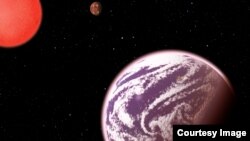Astronomers have discovered what they’re saying is the first planet outside our solar system, or exoplanet, with the same mass as Earth. But although its weight is similar to Earth, the planet is 60 percent larger in diameter.
KOI-314c, which likely has a thick gaseous atmosphere, orbits a dim red dwarf star and is about 200 light-years away. The astronomers said it circles its star every 23 days and that its temperature is around 220 degrees Fahrenheit, too hot for life as we know it.
"This planet might have the same mass as Earth, but it is certainly not Earth-like," says David Kipping of the Harvard-Smithsonian Center for Astrophysics (CfA), lead author of the discovery. "It proves that there is no clear dividing line between rocky worlds like Earth and fluffier planets like water worlds or gas giants."
KOI-314c is only 30 percent denser than water. This suggests that the planet is enveloped by a significant atmosphere of hydrogen and helium hundreds of miles thick. It might have begun life as a mini-Neptune and lost some of its atmospheric gases over time, boiled off by the intense radiation of its star.
Weighing such a small planet was a challenge. Conventionally, astronomers measure the mass of an exoplanet by measuring the tiny wobbles of the parent star induced by the planet's gravity. But this method is extremely difficult for a planet with Earth's mass. The previous record holder for a planet with a measured mass (Kepler-78b) weighed 70 percent more than Earth.
To weigh KOI-314c, the team relied on a different technique known as transit timing variations (TTV). This method can only be used when more than one planet orbits a star. The two planets tug on each other, slightly changing the times that they transit their star.
Using this technique, the astronomers actually found two planets. The second planet in the system, KOI-314b, is about the same size as KOI-314c but significantly denser, weighing about 4 times as much as Earth. It orbits the star every 13 days.
The discovery was serendipitous, as the team was looking for exomoons, not exoplanets.
"When we noticed this planet showed transit timing variations, the signature was clearly due to the other planet in the system and not a moon. At first we were disappointed it wasn't a moon but then we soon realized it was an extraordinary measurement," said Kipping.
Kipping presented this discovery, which was based on data from NASA’s Kepler spacecraft, at the 223rd meeting of the American Astronomical Society.
KOI-314c, which likely has a thick gaseous atmosphere, orbits a dim red dwarf star and is about 200 light-years away. The astronomers said it circles its star every 23 days and that its temperature is around 220 degrees Fahrenheit, too hot for life as we know it.
"This planet might have the same mass as Earth, but it is certainly not Earth-like," says David Kipping of the Harvard-Smithsonian Center for Astrophysics (CfA), lead author of the discovery. "It proves that there is no clear dividing line between rocky worlds like Earth and fluffier planets like water worlds or gas giants."
KOI-314c is only 30 percent denser than water. This suggests that the planet is enveloped by a significant atmosphere of hydrogen and helium hundreds of miles thick. It might have begun life as a mini-Neptune and lost some of its atmospheric gases over time, boiled off by the intense radiation of its star.
Weighing such a small planet was a challenge. Conventionally, astronomers measure the mass of an exoplanet by measuring the tiny wobbles of the parent star induced by the planet's gravity. But this method is extremely difficult for a planet with Earth's mass. The previous record holder for a planet with a measured mass (Kepler-78b) weighed 70 percent more than Earth.
To weigh KOI-314c, the team relied on a different technique known as transit timing variations (TTV). This method can only be used when more than one planet orbits a star. The two planets tug on each other, slightly changing the times that they transit their star.
Using this technique, the astronomers actually found two planets. The second planet in the system, KOI-314b, is about the same size as KOI-314c but significantly denser, weighing about 4 times as much as Earth. It orbits the star every 13 days.
The discovery was serendipitous, as the team was looking for exomoons, not exoplanets.
"When we noticed this planet showed transit timing variations, the signature was clearly due to the other planet in the system and not a moon. At first we were disappointed it wasn't a moon but then we soon realized it was an extraordinary measurement," said Kipping.
Kipping presented this discovery, which was based on data from NASA’s Kepler spacecraft, at the 223rd meeting of the American Astronomical Society.









